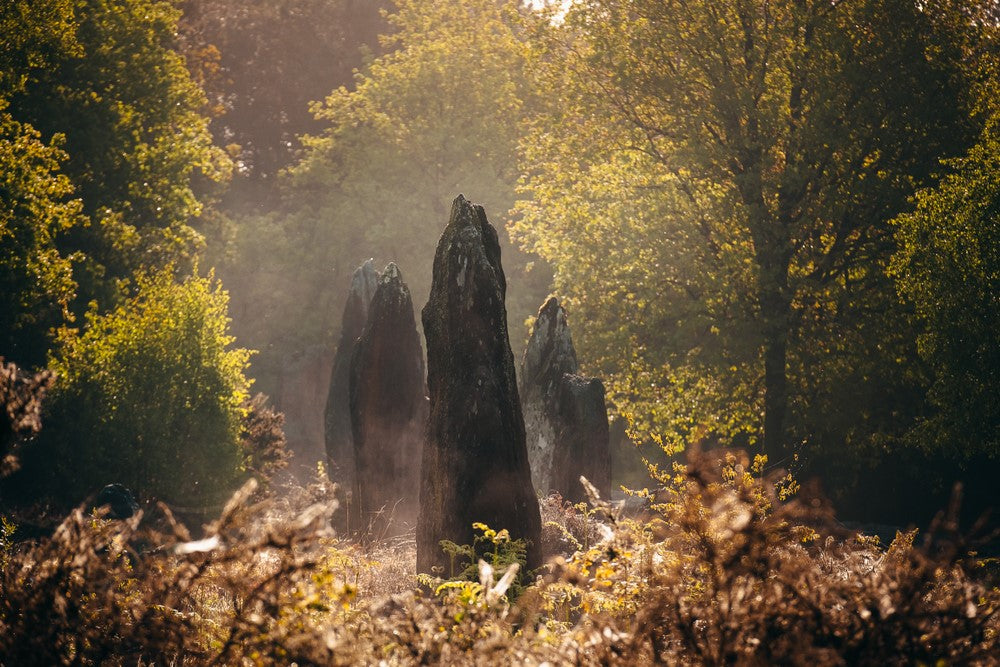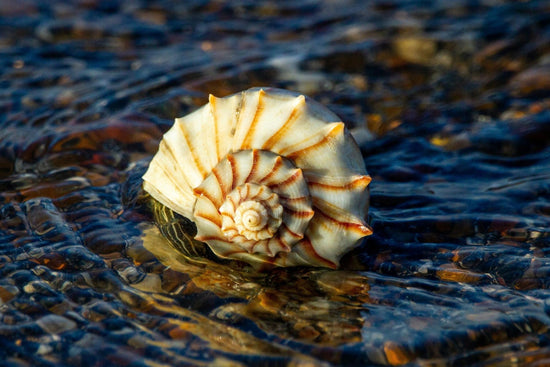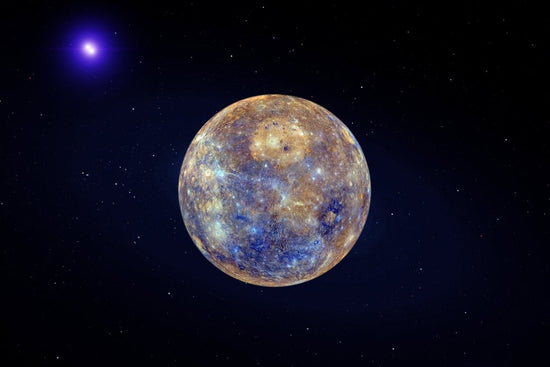Have you noticed a change on the winds? Autumn’s crisp and chilly breath hangs low in the air. Trees don their vermillion robes and brace for the darkening rains ahead, while aromas of coffee and spices waft through the warm kitchen inside. This, dear friends, can only mean one thing: spooky season is upon us.
As we head into a celebration of the autumnal equinox—the so-called holiday Mabon—one can’t help but to wonder: What does Mabon mean to begin with? Where does this name come from, and what lore does it bear? Settle in with a hot cuppa and join us for a journey into the ancient mythology from which this modern pagan festival’s name has arisen.
About the Wheel of the Year

While honoring the autumnal equinox is a millennia-old tradition, its celebration was given the name Mabon (MAY’bn) as recently as the 1970s. This name was chosen by Aidan Kelly, a prominent Wiccan writer and practitioner. Per his own account, Kelly chose this name in an attempt to emulate the myth of Persephone with a character from Welsh mythology.
The now widely used Wheel of the Year was first proposed in 1835 by Jacob Grimm, a well-known German mythologist, writer, and scholar. His work Teutonic Mythology, or Deutsche Mythologie, was a dissertation on the gods and myths known to the Germanic tribes of yore, which bore heavy Celtic influences. While this Wheel of the Year holds no true historical bearing, celebrations of the holidays it names are evidenced across time throughout the Germanic, Gaelic, and Brittonic cultures from which they are derived.
Usage of the Wheel of the Year was popularized by the rise of Wicca, a religion of neo-pagan witchcraft founded by Gerald Gardner and developed throughout the 1950s. It wasn’t until the 1970s that Aidan Kelly recrafted the Wheel to reflect his “aesthetic sensibilities.”
The Origins of the Name “Mabon”

Photo by Birmingham Museums Trust on Unsplash
Kelly noted that several of the holidays on the Wheel already held Gaelic or Gaelic-derived names, as they were directly pulled from existing Celtic pagan practices. These included Imbolc, or Imbolg; Beltane, or Bealtaine; Lammas, or Lughnasadh; and Samhain. (The exception here is Yule, which is Germanic in origin.) It “offended [his] aesthetic sensibilities” that the remaining seasonal festivals (now Ostara, Litha, and Mabon) did not follow suit—these celebrations were simply known as equinoxes or solstices. So, he set about combing through Germanic, Gaelic, and Brittonic mythologies to find stories that satisfied his inspirations.
When it came to renaming the autumnal equinox, Kelly was inspired by the Greek myth of Persephone being whisked away from her mother Demeter and living the Underworld for half the year. This caused her mother, a goddess of agriculture, harvest, and grain, such immense grief that her form turned barren and lifeless, thus creating the seasons of autumn and winter.
It seems the only Celtic story that somewhat fit this archetypal tale was that of a Welsh god called Mabon ap Modron, who was stolen from his mother when he was only three nights old and imprisoned in an underwater dungeon, where no one had seen or heard of him since.
Who Is Mabon?

Mabon (MAH-bon), otherwise known as Mabon ap Modron, is a character in Welsh mythology. His name literally translates to ‘the divine son of a divine mother.’ This Mabon is scarcely mentioned beyond a singular tale in the Mabinogi (often called the Mabinogion), a medieval collection of Welsh prose from the 11th and 14th centuries.
The Mabinogi primarily features tales about mothers or goddesses who are separated from their sons, and their sons, who are destined for great leadership as heroes or kings. Considering this parallel to Mabon’s mythology, it seems quite possible that Mabon had something to do with the naming of the Mabinogi. While these tales likely could have been used in instructing sons of noble lineage on how to conduct themselves as men, it’s clear the stories had existed in the surrounding culture for much longer.
Mabon ap Modron may be related to a Gaulish Celtic deity called Maponos, as both the names Mabon and Maponos mean ‘divine son,’ ‘divine youth,’ or ‘great son,’ where Modron simply means mother, or ‘divine mother.’
Much of what we know about Gaulish Celtic deities comes from the accounts of Julius Caesar. As such, the deities are reliably conflated with Roman gods that he saw as fit equivalents. Caesar equated the Gaulish Maponos with the Greco-Roman Apollo, a god of medicine, music, and poetry, among many other things. The Celtic and Roman associations of dogs with healing draws another thread of connection from Apollo and Maponos to Mabon, given Mabon’s affinity for dogs.
This Mabon appears only in the Mabinogi’s tale of Culhwch and Olwen. The story goes that Culhwch seeks the hand of Olwen, the daughter of the chief of all giants. Olwen’s father sets forth a series of seemingly impossible tasks for Culhwch to complete for his wedding. One of these tasks requires him to find the fabled prison of Mabon, son of Modron, for Mabon is the only man able to handle a certain hound called Drudwyn. With the help of his cousin, King Arthur, Culhwch manages to find and free Mabon, complete his quest, and marry Olwen.
As with most Welsh sagas, the tale of Culhwch and Olwen is a long and winding one. The story that follows is abridged at best, but illustrates the role of Mabon to the best of our ability.
The Tale of Culhwch and Olwen

Photo by Nathan Field on Unsplash
Culhwch, son of Cilydd, was cursed as a boy to fall in love with a maiden named Olwen, daughter of Ysbaddaden, chief of the giants. In his ardent yet woeful longing for the girl he’d never met, Culhwch’s father urged him to seek counsel from his cousin, King Arthur, who surely would lend his hand to Culhwch’s quest.
So, Culhwch charged into King Arthur’s court and demanded aid from his cousin. His cousin agreed, and together with Arthur’s men, they left to seek the giant Ysbaddaden to ask for his daughter’s hand.
After a long search, the men at last found Ysbaddaden’s castle, which lay beyond a flock of sheep. Upon learning of their quest, the shepherd in the field warned them that none who sought Olwen’s hand came out alive. As it turns out, the giant Ysbaddaden was fated to die on the day of Olwen’s wedding—so you understand his disinterest in marrying away his daughter!
Instructed to accept each of the giant’s requests, Culhwch presented himself before Ysbaddaden and asked for Olwen’s hand. The giant accepted only conditionally, and proceeded to lay out a slew of outrageous tasks he insisted must be completed for the wedding if Culhwch was to marry Olwen.
Knowing his cousin Arthur would assist him, Culhwch accepted heartily.

Photo by Svetlana Sinitsyna on Unsplash
Among these wishes was a request to retrieve a tusk from the giant boar Twrch Trwyth; given his giant-ish nature, this was apparently the only tool able to groom Ysbaddaden properly for the wedding. In order to hunt the boar, they needed a special hound called Drudwyn. Only one man was known to be able to handle the hound Drudwyn, and this was Mabon ap Modron.
The only problem was that Mabon was stolen from his mother, Modron, when he was only three nights old; no one in all the lands knew where he was imprisoned.
In their search for Mabon, Arthur and his men sought out ancient animal after ancient animal, from the Blackbird of Cilgwri to the Stag of Rhedynfre, the Owl of Cwm Cawlwyd, and the Eagle of Gwernabwy, but none had seen or heard of Mabon ap Modron.
Finally, the men came upon the great Salmon of Llyn Llyw, who seemed to be the oldest animal on the Earth. He told Arthur of a place he knew from swimming up the river with every tide, where he had heard Mabon wailing in a cave, lamenting his imprisonment.

Photo by Martin Sanchez on Unsplash
The men traveled up the River Severn to the shores of Gloucester Castle. Sure enough, they had found the hiding place of Mabon ap Modron and Culhwch and Arthur set about freeing him. Upon his release, Mabon took command of the great hound Drudwyn, and together they began their hunt of the giant boar Twrch Trwyth.
Having slain the boar, Culhwch, Arthur, and his men traveled across land and sea until Ysbaddaden’s wishes were finally fulfilled. The giant yielded his daughter at last. Culhwch and Olwen were wed, Ysbaddaden was beheaded, and Culhwch took charge of the kingdom in his stead. King Arthur returned home with his men.
As for Mabon ap Modron, well, we can only hope he still wanders free throughout the lands, wind in his hair, far from the waters that held him deep within the Earth for so many thousands of years.
Mabon and the Autumn Equinox

Photo by freestocks on Unsplash
As you can see, there is hardly a connection between Mabon ap Modron and the season of autumn at all. It was an odd and perhaps appropriative choice on the part of Aidan Kelly to draw a nearly out-of-reach analogy between this character and the more familiar Persephone. However, because of the widespread popularity of the Wheel of the Year in neopagan practices, this new name for the autumnal equinox likely isn’t going anywhere.
We therefore find it important to fully clarify the origins of the holiday’s name. As Kris Hughes says in her video detailing historical evidence of Mabon and Maponos, these often untethered modern uses of ancient names “tend to obscure the historical or mythological identity of the deity.”
While the deity Mabon (MAH-bon) may have little to do with the celebration of Mabon (MAY’bn), this time of year nonetheless provides an opportunity for release, reflection, and taking a closer look at the origins of the stories that surround us.
Happy Autumn-ing, Witches.





